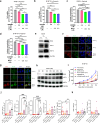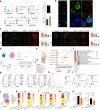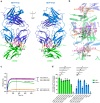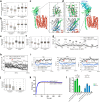A basigin antibody modulates MCTs to impact tumor metabolism and immunity
- PMID: 40324980
- PMCID: PMC12053622
- DOI: 10.1038/s41421-025-00777-1
A basigin antibody modulates MCTs to impact tumor metabolism and immunity
Abstract
Lactate metabolism and signaling intricately intertwine in the context of cancer and immunity. Basigin, working alongside monocarboxylate transporters MCT1 and MCT4, orchestrates the movement of lactate across cell membranes. Despite their potential in treating formidable tumors, the mechanisms by which basigin antibodies affect basigin and MCTs remain unclear. Our research demonstrated that basigin positively modulates MCT activity. We subsequently developed a basigin antibody that converts basigin into a negative modulator, thereby suppressing lactate transport and enhancing anti-tumor immunity. Additionally, the antibody alters metabolic profiles in NSCLC-PDOs and T cells. Cryo-EM structural analysis and molecular dynamics simulations reveal that the extracellular Ig2 domain and transmembrane domain of basigin regulate MCT1 activity through an allosteric mechanism. The antibody decreases MCT1 transition rate by reducing the flexibility of basigin's Ig2 domain and diminishing interactions between basigin's transmembrane domain and MCT1. These findings underscore the promise of basigin antibodies in combating tumors by modulating metabolism and immunity, and the value of a common therapeutic subunit shared by multiple transporter targets.
© 2025. The Author(s).
Conflict of interest statement
Conflict of interest: ShanghaiTech University has filed a patent application on behalf of the authors regarding the antibody sequence and applications. Jun Liao is a founder of Alphelix Biosciences and a member of its scientific advisory board.
Figures







References
Grants and funding
- 2017YFA0504800/Ministry of Science and Technology of the People's Republic of China (Chinese Ministry of Science and Technology)
- 2018ZX09711003-003-003/Ministry of Science and Technology of the People's Republic of China (Chinese Ministry of Science and Technology)
- 2017YFA0504800/Ministry of Science and Technology of the People's Republic of China (Chinese Ministry of Science and Technology)
- 2018ZX09711003-003-003/Ministry of Science and Technology of the People's Republic of China (Chinese Ministry of Science and Technology)
- 2017YFA0504800/Ministry of Science and Technology of the People's Republic of China (Chinese Ministry of Science and Technology)
- 92353304/National Natural Science Foundation of China (National Science Foundation of China)
- 21821004/National Natural Science Foundation of China (National Science Foundation of China)
- 82160447/National Natural Science Foundation of China (National Science Foundation of China)
- 82160447/National Natural Science Foundation of China (National Science Foundation of China)
- 82160447/National Natural Science Foundation of China (National Science Foundation of China)
- 92053202/National Natural Science Foundation of China (National Science Foundation of China)
- 92353304/National Natural Science Foundation of China (National Science Foundation of China)
- 21821004/National Natural Science Foundation of China (National Science Foundation of China)
- 32170924/National Natural Science Foundation of China (National Science Foundation of China)
- 82160447/National Natural Science Foundation of China (National Science Foundation of China)
- 92053202/National Natural Science Foundation of China (National Science Foundation of China)
- 92353304/National Natural Science Foundation of China (National Science Foundation of China)
- 21821004/National Natural Science Foundation of China (National Science Foundation of China)
- 2021D01C027/Natural Science Foundation of Xinjiang Province (Xinjiang Natural Science Foundation)
LinkOut - more resources
Full Text Sources

